Ammonia Emissions Measured Using Two Different GasFinder Open-Path Lasers
Abstract
1. Introduction
2. Experiments
2.1. Description of GasFinder Open Path Laser
2.2. Experiemtal Sites, Sensor Installations and Data Acquisition
2.2.1. NH3 Measurements at Outdoor Manure Compost Windrows
2.2.2. NH3 Measurements from Fertilized Wheat Stubble
2.3. Data Processing
2.3.1. NH3 Concentration Data Processing
2.3.2. Calculating NH3 Emission Rates
3. Results and Discussion
3.1. Environmental Data
3.2. NH3 Concentrations Measured by GasFinder 2 & 3
3.2.1. NH3 Concentrations at the Composting Facility
3.2.2. NH3 Concentrations Measured at the Field Trial
3.3. NH3 Emissions at the Field Trial
4. Conclusions
Author Contributions
Acknowledgments
Conflicts of Interest
References
- Behera, S.N.; Sharma, M.; Aneja, V.P.; Balasubramanian, R. Ammonia in the atmosphere: A review on emission sources, atmospheric chemistry and deposition on terrestrial bodies. Environ. Sci. Pollut. Res. 2013. [Google Scholar] [CrossRef] [PubMed]
- Hertel, O.; Geels, C.; Frohn, L.M.; Ellermann, T.; Skjoth, C.A.; Lostrom, P.; Christensen, J.H.; Andersen, H.V.; Peel, R.G. Assessing atmospheric nitrogen deposition to natural and semi-natural ecosystems—experience from Danish studies using the DAMOS. Atmos. Environ. 2013, 66, 151–160. [Google Scholar] [CrossRef]
- Sintermann, J.; Neftel, A.; Ammann, C.; Häni, C.; Hensen, A.; Loubet, B.; Flechard, C.R. Are ammonia emissions from field-applied slurry substantially over-estimated in European emission inventories? Biogeosciences 2012, 9, 1611–1632. [Google Scholar] [CrossRef]
- Flesch, T.K.; Wilson, J.D.; Yee, E. Backward-time Lagrangian stochastic dispersion models and their application to estimate gaseous emissions. J. Appl. Meteorol. 1995, 34, 1320–1332. [Google Scholar] [CrossRef]
- McGinn, S.M.; Flesch, T.K.; Crenna, B.P.; Beauchemin, K.A.; Coates, T. Quantifying ammonia emissions from a cattle feedlot using a dispersion model. J. Environ. Qual. 2007, 36, 1585–1590. [Google Scholar] [CrossRef] [PubMed]
- von Bobrutzki, K.; Braban, C.F.; Famulari, D.; Jones, S.K.; Blackall, T.; Smith, T.E.L.; Blom, M.; Coe, H.; Gallagher, M.; Ghalaieny, M.; et al. Field inter-comparison of eleven atmospheric ammonia measurement techniques. Atmos. Meas. Tech. 2010, 3, 91–112. [Google Scholar] [CrossRef]
- Ni, K.; Köster, J.R.; Seidel, A.; Pacholski, A. Field measurement of ammonia emissions after nitrogen fertilization—A comparison between micrometeorological and chamber methods. Eur. J. Agron. 2015, 71, 115–122. [Google Scholar] [CrossRef]
- Yang, W.; Zhu, A.; Zhang, J.; Xin, X.; Zhang, X. Evaluation of a backward Lagrangian stochastic model for determining surface ammonia emissions. Agric. For. Meteo. 2017, 234–235, 196–202. [Google Scholar] [CrossRef]
- Baldé, H.; VanderZaag, A.C.; Burtt, S.D.; Wagner-Riddle, C.; Evans, L.; Gordon, R.; Desjardins, R.L.; MacDonald, J.D. Ammonia emissions from liquid manure storages are affected by anaerobic digestion and solid-liquid separation. Agric. For. Meteorol. 2018. [Google Scholar] [CrossRef]
- Boreal Laser, Inc. GasFinder3-OP: Portable Open-Path TDL Analyser. Available online: http://www.boreal-laser.com/products/portable-open-path-tdl-analyzer/ (accessed on 30 April 2018).
- Boreal Laser, Inc. GasFinder2-OP: Portable Open-Path TDL Analyser. Available online: http://www.boreal-laser.com/products/gasfinder2-op/ (accessed on 30 April 2018).
- U.S. Environmental Protection Agency (EPA). Method 301–Field Validation of Pollutant Measurement Methods from Various Waste Media. Available online: https://www.epa.gov/emc/method-301-field-validation-pollutant-measurement-methods-various-waste-media (accessed on 30 April 2018).
- Grant, R.H.; Boehm, M.T.; Lawrence, A.F.; Heber, A.J. Ammonia emissions from anaerobic treatment lagoons at sow and finishing farms in Oklahoma. Agric. For. Meteorol. 2013, 180, 203–210. [Google Scholar] [CrossRef]
- U.S. Environmental Protection Agency (EPA) and Battelle. The Environmental Technology Verification (ETV). Evaluation of the performance of GasFinder 2.0 TDL Open-Path Monitor. Available online: https://archive.epa.gov/nrmrl/archive-etv/web/pdf/01_vs_boreal.pdf (accessed on 30 April 2018).
- Flesch, T.K.; Wilson, J.D.; Harper, L.A.; Crenna, B.P.; Sharpe, R.R. Deducing ground-air emissions from observed trace gas concentrations: A field trial. J. Appl. Meteorol. 2004, 43, 487–502. [Google Scholar] [CrossRef]
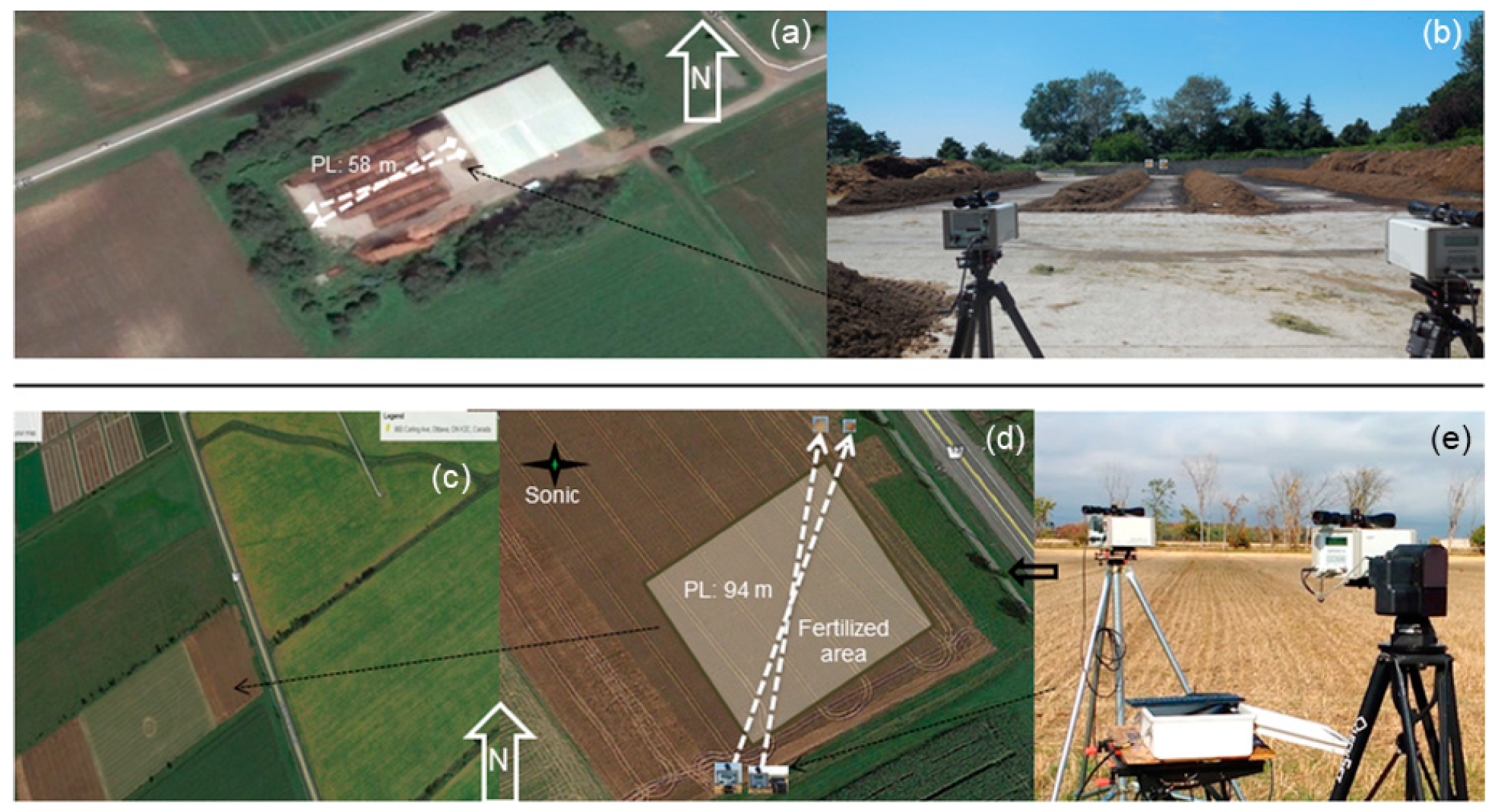
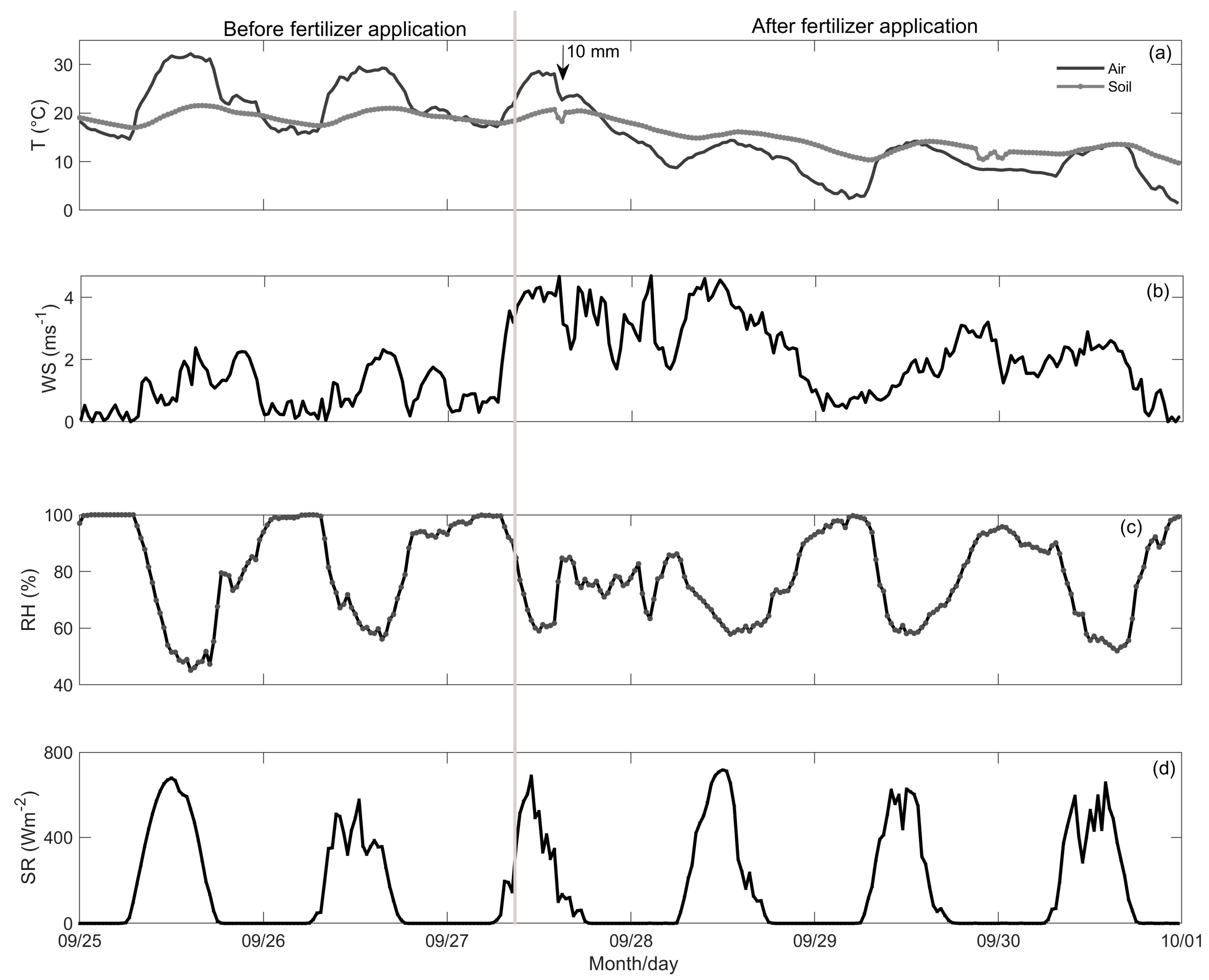

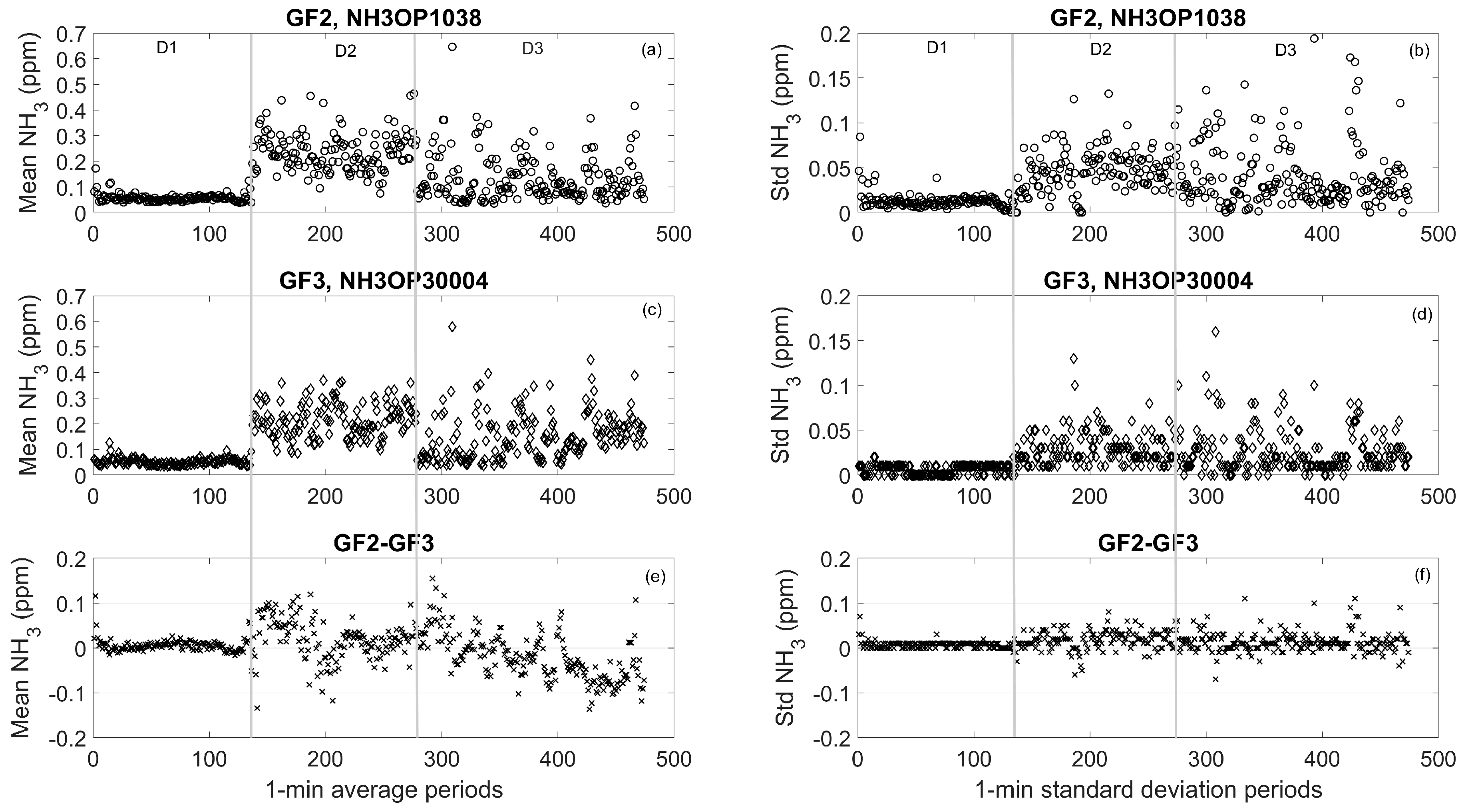
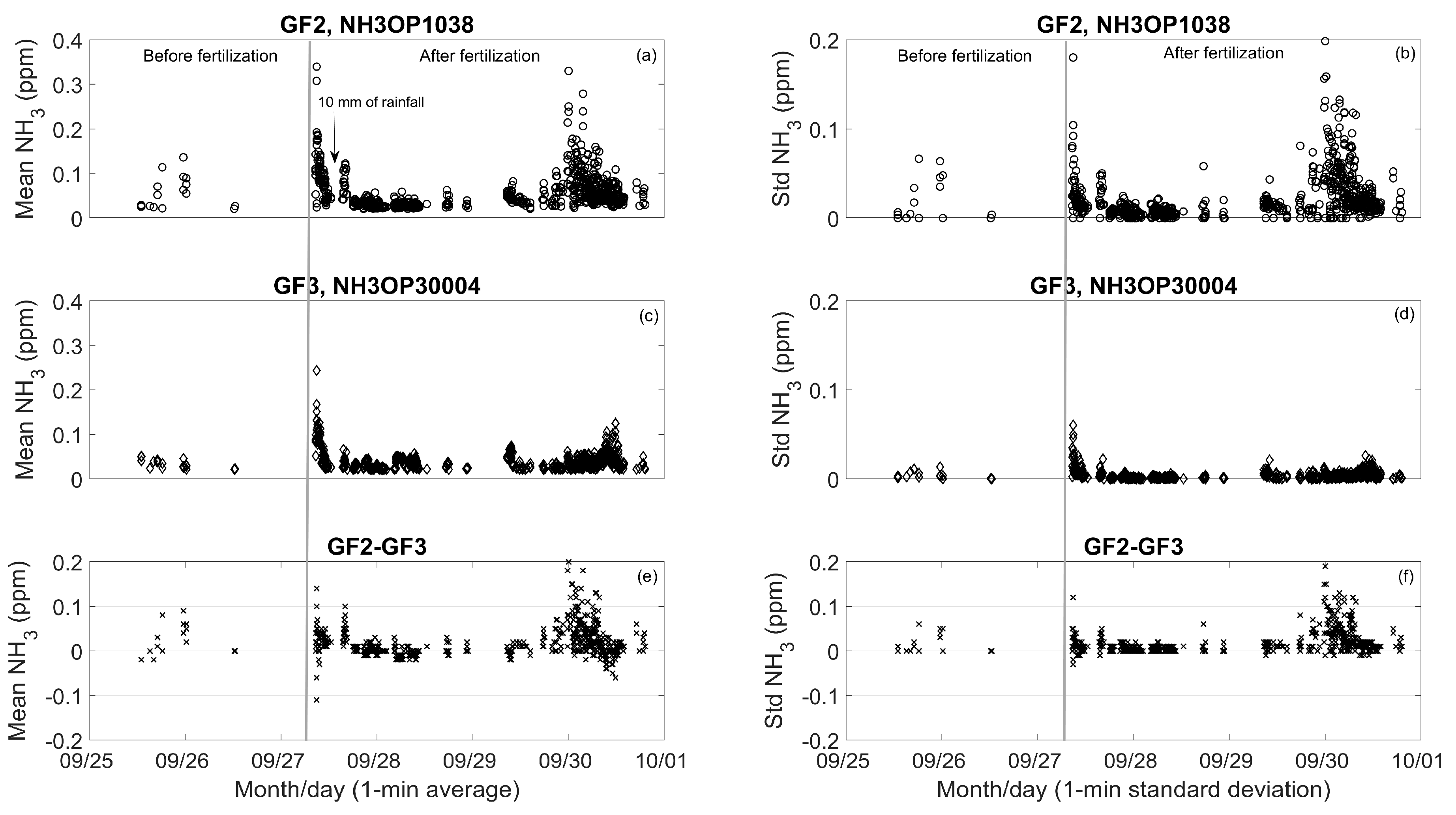
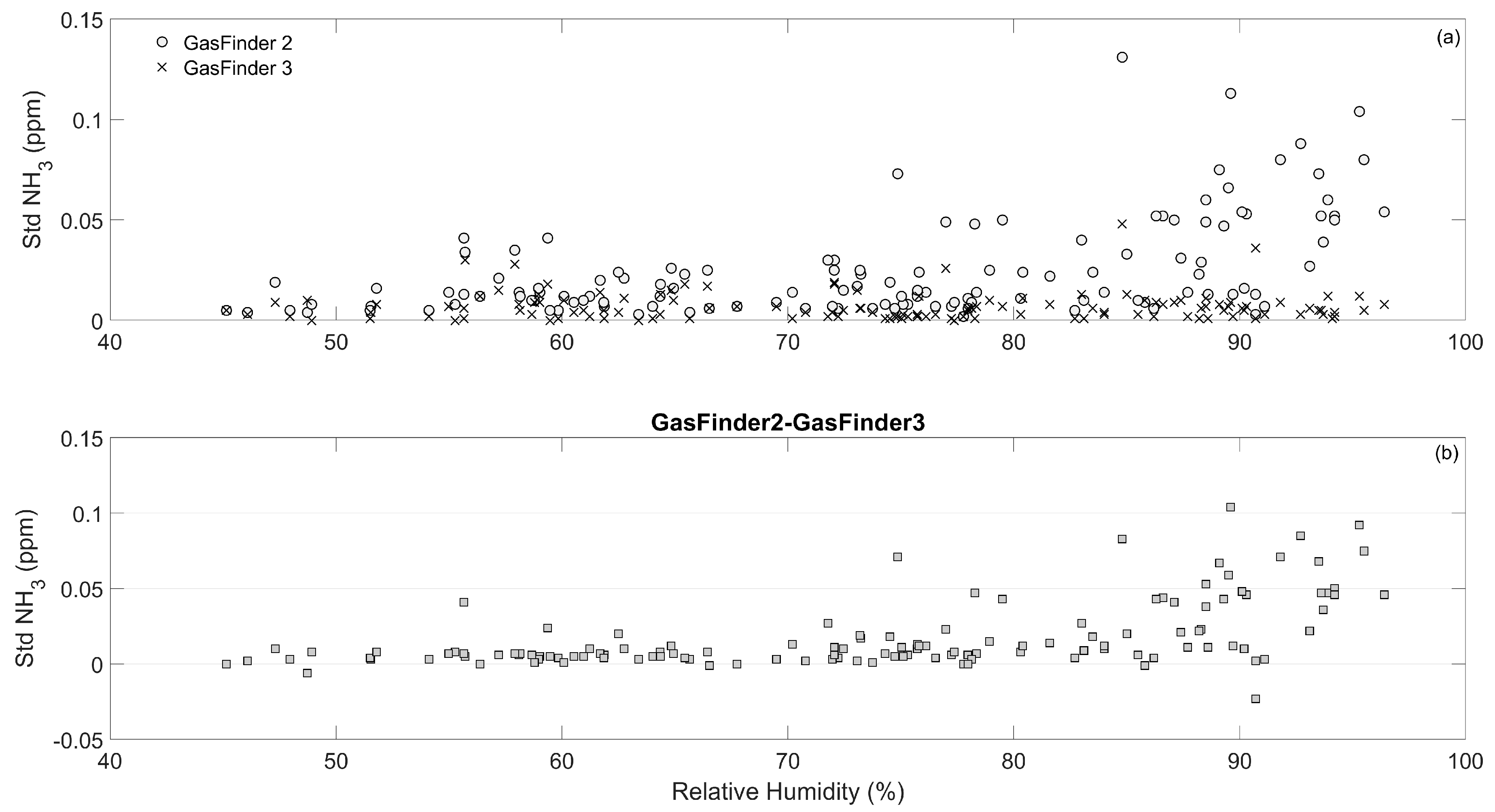
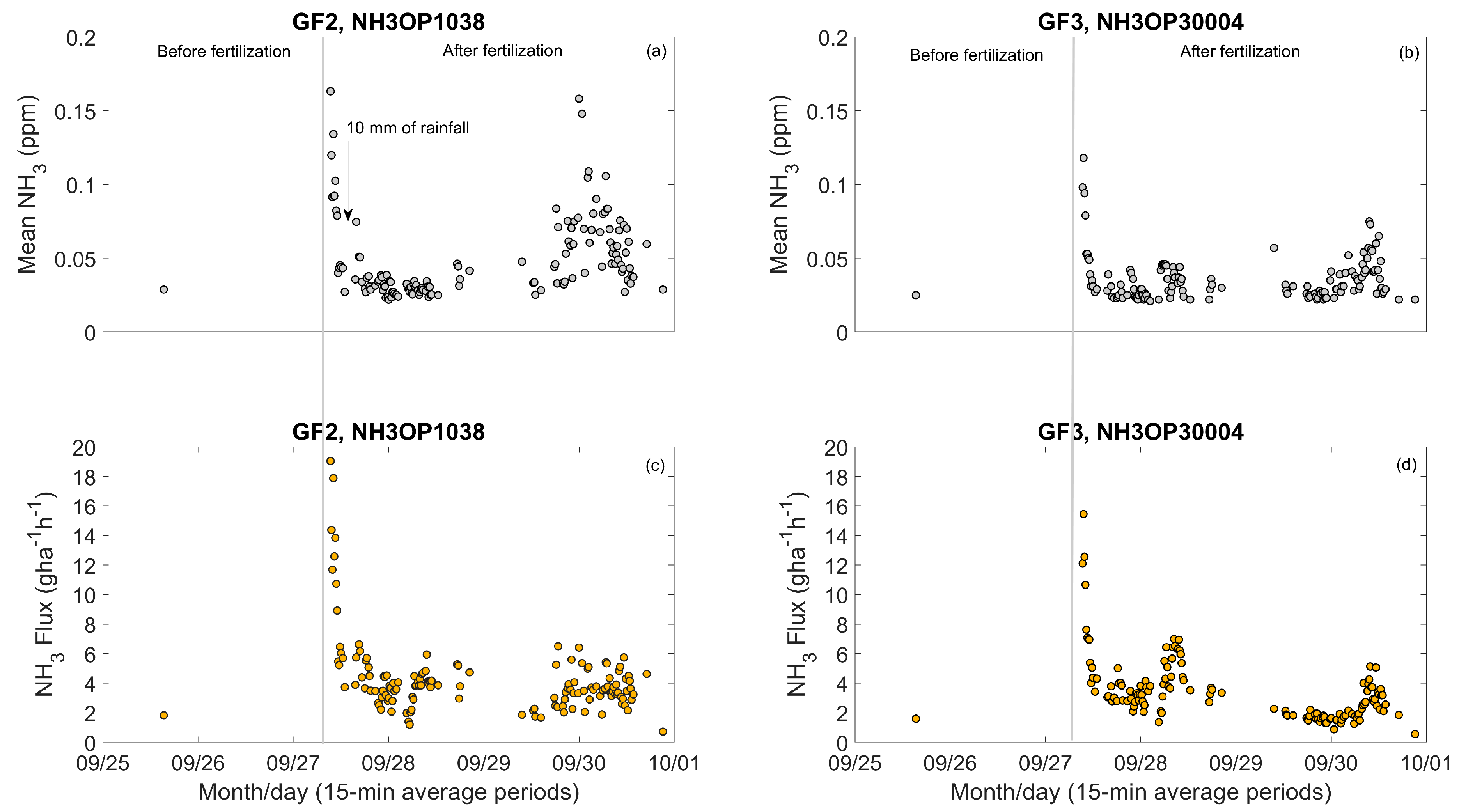

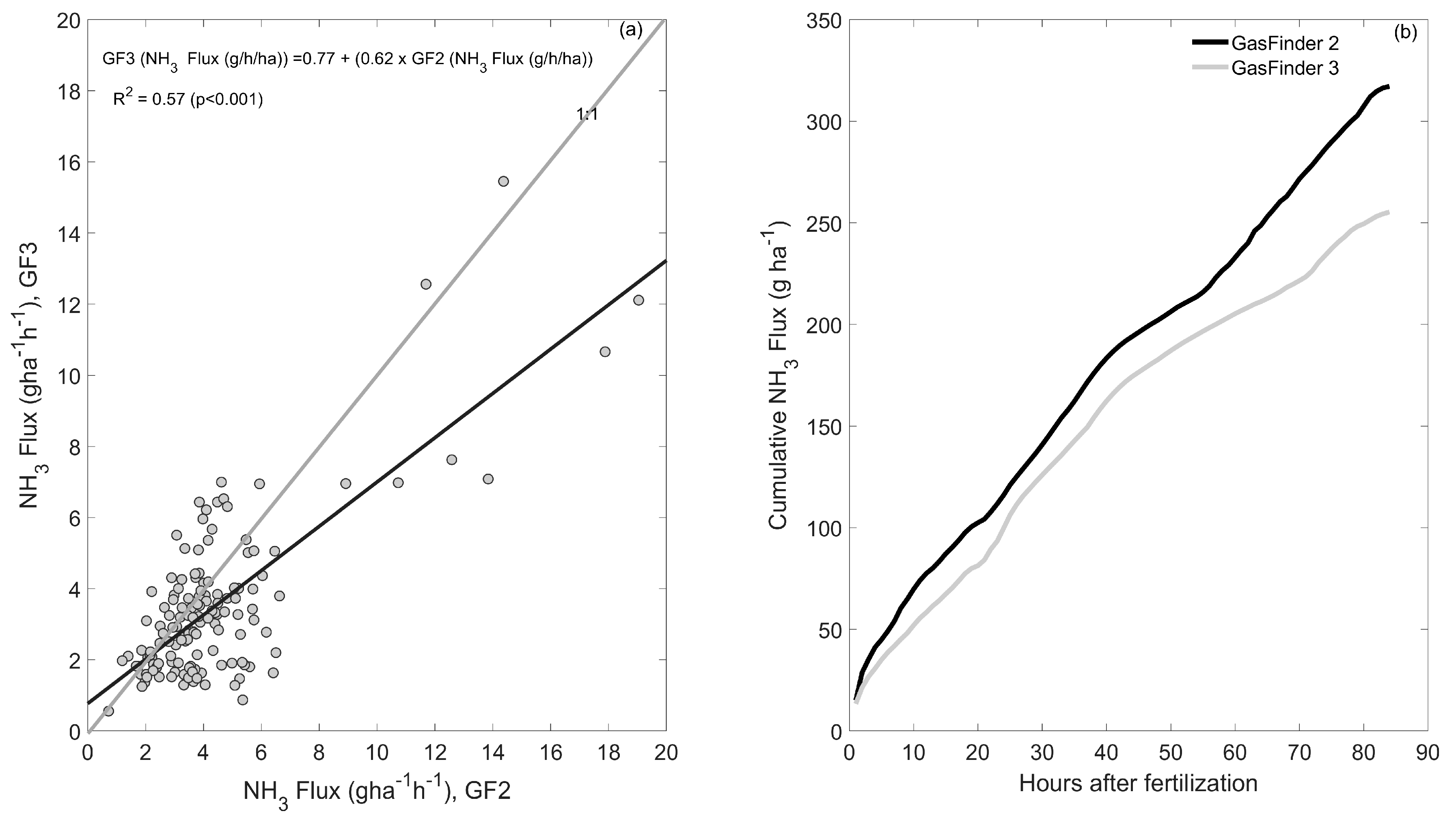
| Date | Hour | Air Temperature | Solar Radiation | Wind Speed | Wind Direction | Relative Humidity |
|---|---|---|---|---|---|---|
| Eastern Time | °C | MJ m−2 | m s−1 | ° | % | |
| 2017-07-27 | 10 | 21.6 | 2.1 | 4.4 | 297 | 73 |
| 11 | 21.7 | 1.5 | 4.9 | 290 | 71 | |
| 12 | 21.4 | 1.2 | 5.0 | 279 | 70 | |
| 13 | 22.7 | 2.8 | 4.8 | 268 | 66 | |
| Average | 21.9 | 1.9 | 4.8 | 284 | 70 | |
| 2017-07-28 | 9 | 16.6 | 2.2 | 3.7 | 338 | 61 |
| 10 | 17.7 | 2.8 | 3.7 | 328 | 55 | |
| 11 | 18.8 | 3.1 | 4.6 | 337 | 42 | |
| 12 | 20 | 3.1 | 4.2 | 176 | 39 | |
| 13 | 20.9 | 3.3 | 5.0 | 348 | 39 | |
| 14 | 21.5 | 3.1 | 4.5 | 337 | 40 | |
| Average | 19.3 | 2.9 | 4.3 | 311 | 46 | |
| 2017-08-01 | 9 | 22.6 | 2.1 | 0.8 | 85 | 54 |
| 10 | 24.3 | 2.6 | 0.6 | 186 | 44 | |
| 11 | 25.3 | 3.0 | 0.9 | 75 | 43 | |
| 12 | 26.2 | 3.2 | 1.4 | 196 | 37 | |
| 13 | 27 | 3.2 | 2.6 | 208 | 38 | |
| 14 | 27.6 | 3.1 | 2.1 | 197 | 41 | |
| Average | 25.5 | 2.9 | 1.4 | 157.8 | 42.8 |
| Parameters | Sensor | Composting Facility | Wheat Stubble | ||||
|---|---|---|---|---|---|---|---|
| All Days | D1 | D2 | D3 | Before Fertilizer | After Fertilizer | ||
| Mean [NH3] (ppm) 1 min periods | GF2 | 0.1417 | 0.057 | 0.235 | 0.134 | 0.054 | 0.062 |
| GF3 | 0.1418 | 0.052 | 0.216 | 0.152 | 0.034 | 0.041 | |
| p-value | 0.972 | <0.001 | <0.001 | <0.001 | 0.034 | <0.001 | |
| n | 474 | 136 | 139 | 199 | 18 | 736 | |
| Ratio: GF2/GF3 | 0.999 | 1.10 | 1.09 | 0.88 | 1.59 | 1.51 | |
| Mean 1 min σ (ppm) | GF2 | 0.034 | 0.013 | 0.048 | 0.040 | 0.018 | 0.024 |
| GF3 | 0.022 | 0.006 | 0.030 | 0.027 | 0.004 | 0.004 | |
| Ratio: GF2/GF3 | 1.55 | 2.17 | 1.60 | 1.48 | 4.50 | 6.00 | |
| σ/mean | GF2 | 24% | 23% | 20% | 30% | 33% | 39% |
| GF3 | 16% | 12% | 14% | 18% | 12% | 10% | |
| Mean NH3 Flux (g ha−1 h−1) | GF2 | No flux calculation | 4.34 | ||||
| GF3 | 3.48 | ||||||
| p-value | <0.001 | ||||||
| Ratio: GF2/GF3 | 1.25 | ||||||
© 2019 by the authors. Licensee MDPI, Basel, Switzerland. This article is an open access article distributed under the terms and conditions of the Creative Commons Attribution (CC BY) license (http://creativecommons.org/licenses/by/4.0/).
Share and Cite
Baldé, H.; VanderZaag, A.; Smith, W.; Desjardins, R.L. Ammonia Emissions Measured Using Two Different GasFinder Open-Path Lasers. Atmosphere 2019, 10, 261. https://doi.org/10.3390/atmos10050261
Baldé H, VanderZaag A, Smith W, Desjardins RL. Ammonia Emissions Measured Using Two Different GasFinder Open-Path Lasers. Atmosphere. 2019; 10(5):261. https://doi.org/10.3390/atmos10050261
Chicago/Turabian StyleBaldé, Hambaliou, Andrew VanderZaag, Ward Smith, and Raymond L. Desjardins. 2019. "Ammonia Emissions Measured Using Two Different GasFinder Open-Path Lasers" Atmosphere 10, no. 5: 261. https://doi.org/10.3390/atmos10050261
APA StyleBaldé, H., VanderZaag, A., Smith, W., & Desjardins, R. L. (2019). Ammonia Emissions Measured Using Two Different GasFinder Open-Path Lasers. Atmosphere, 10(5), 261. https://doi.org/10.3390/atmos10050261






